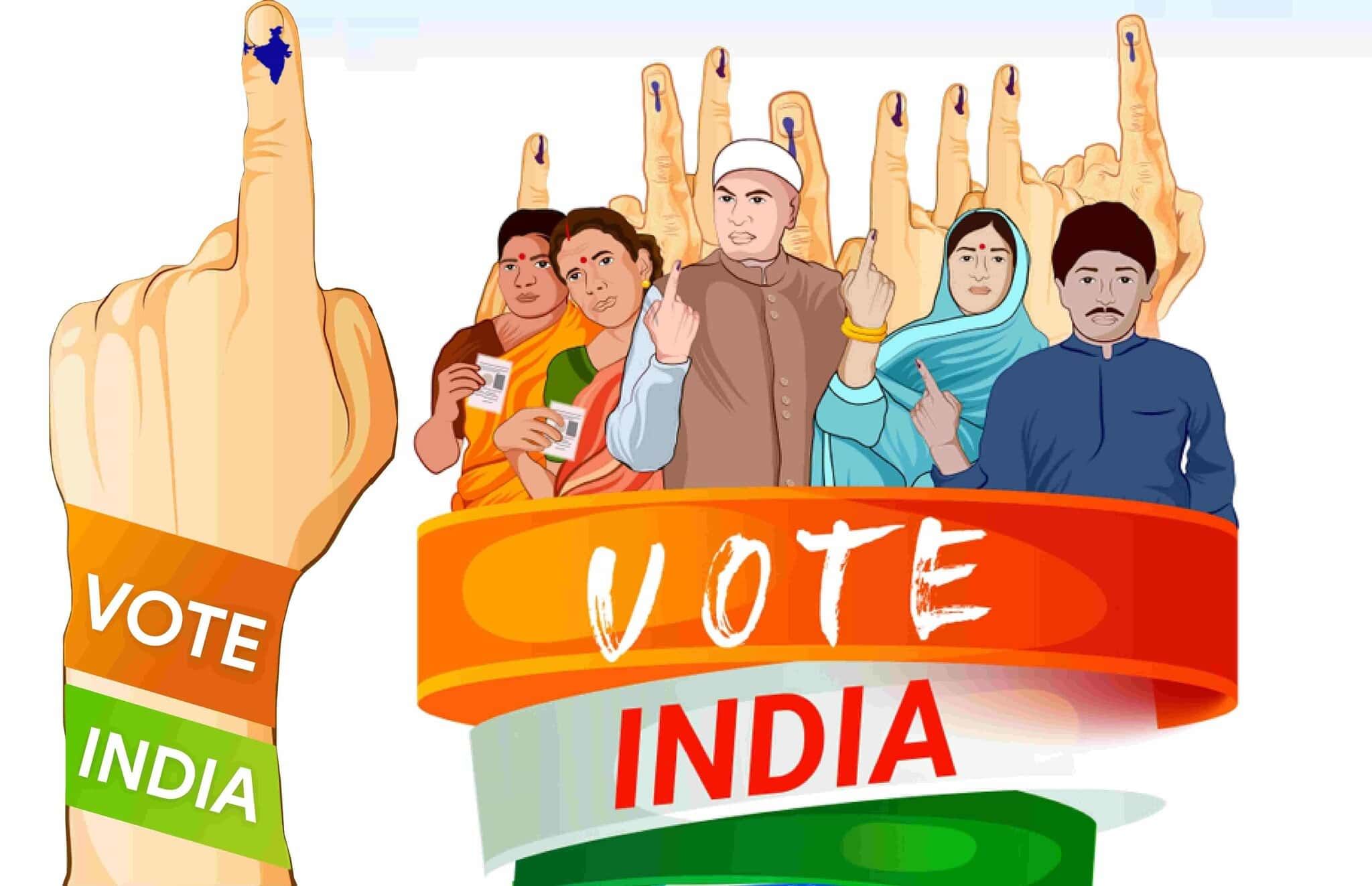Unit Test (Solutions): Universal Franchise and India’s Electoral System | Social Science Class 8 - New NCERT PDF Download
Time: 1 Hour
M.M.: 30
Attempt all questions.
Question numbers 1 to 4 carry 1 mark each.
Question numbers 5 and 6 carry 2 marks each.
Question numbers 7 to 10 carry 3 marks each.
Question numbers 11 and 12 carry 5 marks each.
Q1. At what age does an Indian citizen become eligible to vote in elections?
(a) 16
(b) 18
(c) 21
(d) 25
Ans: (b) 18
Every Indian citizen aged 18 and above has the right to vote, as per the principle of universal adult franchise outlined in the Indian Constitution.
Q2. Universal adult franchise in India means:
(a) Only men can vote
(b) Only educated people can vote
(c) Every adult citizen has an equal right to vote
(d) Voting is compulsory
Ans: (c) Every adult citizen has an equal right to vote
Universal adult franchise ensures that all Indian citizens aged 18 and above have an equal right to vote, regardless of caste, creed, religion, gender, or education.
Q3. Is it true or false that the Election Commission of India is a constitutional body established in 1950?
Ans: True
The Election Commission of India (ECI) was established in 1950 as an independent constitutional body to oversee free and fair elections.
Q4. Which article of the Indian Constitution grants the right to vote to all adult citizens?
(a) Article 14
(b) Article 326
(c) Article 19
(d) Article 370
Ans: (b) Article 326
Article 326 of the Indian Constitution establishes universal adult franchise, granting the right to vote to all citizens aged 18 and above.
Q5. Name two assistive technologies introduced by the Election Commission of India to help voters with disabilities in 2024.
Ans: Braille-enabled voter cards and app-based requests for wheelchairs and ramps.
Q6. What is the Model Code of Conduct (MCC), and why is it important during elections?
Ans: The Model Code of Conduct (MCC) is a set of rules ensuring free and fair elections by guiding political parties and candidates. It prevents misuse of government resources, prohibits voter inducements, and promotes peaceful elections, maintaining electoral integrity and fairness.
Q7. Explain the “First-Past-the-Post” electoral system used in Indian Lok Sabha and assembly elections.
Ans: The “First-Past-the-Post” (FPTP) system is a simple yet effective electoral method used in India’s Lok Sabha and state assembly elections to determine winners in each constituency.
- Definition: The candidate with the most votes in a constituency wins, even without securing a majority (50%) of votes.
- Application: Used for electing Members of Parliament (MPs) to the Lok Sabha and Members of Legislative Assemblies (MLAs) in states.
- Process: Voters choose one candidate, and the candidate with the highest vote count in each of the 543 Lok Sabha constituencies is declared the winner.
- Impact: Ensures straightforward results but may not always reflect proportional representation.
Q8. How does the Election Commission of India ensure free and fair elections in a country as diverse and large as India?
Ans: The Election Commission of India (ECI) employs robust measures to ensure free and fair elections across India’s vast and diverse landscape, addressing logistical and social challenges.
- Accessibility: Deploys officials to remote areas and introduced home voting for elderly and disabled voters in 2024.
- Technology: Uses electronic voting machines and assistive technologies like braille-enabled cards and wheelchair apps to aid inclusivity.
- Model Code of Conduct (MCC): Enforces rules to prevent misuse of government resources and voter inducements, ensuring a level playing field.
- Scale Management: Oversees elections for 980 million voters across 543 constituencies with efficient systems and schedules.
Q9. Discuss the role of the Rajya Sabha and how its members are elected.
Ans: The Rajya Sabha, India’s upper house of Parliament, plays a crucial role in the legislative process, and its members are elected indirectly to ensure representation of states.
- Role: Reviews and amends legislation, provides a platform for state interests, and remains a permanent house, never dissolving.
- Composition: Consists of 245 members, with 233 elected by state MLAs and 12 nominated by the President for expertise in various fields.
- Election Process: Elected by MLAs using the single transferable vote system, with seats allocated based on state population.
- Tenure: Members serve six-year terms, with one-third retiring every two years to maintain continuity.
Q10. Describe the composition and election process of the President of India.
Ans: The President of India, the ceremonial head of state, is elected indirectly through a carefully designed process to reflect both central and state representation.
- Electoral College: Comprises elected MPs from Lok Sabha and Rajya Sabha, and elected MLAs from states and union territories (Delhi and Puducherry).
- Exclusions: Nominated Rajya Sabha members, nominated MLAs, and members of state legislative councils do not vote.
- Voting System: Uses the single transferable vote system to ensure broad support from both central and state governments.
- Weighting: Votes are weighted based on state population, giving larger states greater influence, ensuring democratic legitimacy.
Q11. Analyze the challenges faced by India’s electoral system today and suggest measures to strengthen voter participation.
Ans: India’s electoral system, the world’s largest democratic exercise, faces significant challenges that impact its effectiveness, but targeted measures can enhance voter participation.
Challenges:
- Money Power: Excessive use of financial resources in campaigns influences voters and undermines fairness.
- Criminal Records: Candidates with criminal backgrounds compromise the integrity of the electoral process.
- Voter Apathy: Low turnout, especially in urban areas, weakens democratic engagement.
Measures to Strengthen Participation:
- Voter Education: Launch media and school campaigns to inform youth about the importance of voting.
- Awareness Initiatives: Promote civic responsibility through community programs to boost turnout.
- Transparency: Strengthen enforcement against money power and ensure stricter scrutiny of candidates’ backgrounds.
Q12. Compare the election processes of the Lok Sabha, Rajya Sabha, and the President of India, highlighting the differences in their electoral colleges and voting methods.
Ans: The election processes for the Lok Sabha, Rajya Sabha, and President of India differ significantly in their electoral colleges and voting methods, reflecting their distinct roles in India’s democracy.
Differences in Electoral Processes
Key Differences: Lok Sabha elections involve direct public voting, while Rajya Sabha and Presidential elections are indirect, involving elected representatives. The First-Past-the-Post system applies only to the Lok Sabha, while the single transferable vote ensures broader representation for the Rajya Sabha and the President.
|
31 videos|128 docs|7 tests
|
FAQs on Unit Test (Solutions): Universal Franchise and India’s Electoral System - Social Science Class 8 - New NCERT
| 1. What is universal franchise and how does it apply to India's electoral system? |  |
| 2. How does the electoral process work in India? |  |
| 3. What are the key features of India's electoral system? |  |
| 4. What role does the Election Commission of India play in the electoral system? |  |
| 5. Why is the concept of universal franchise important for democracy in India? |  |



















